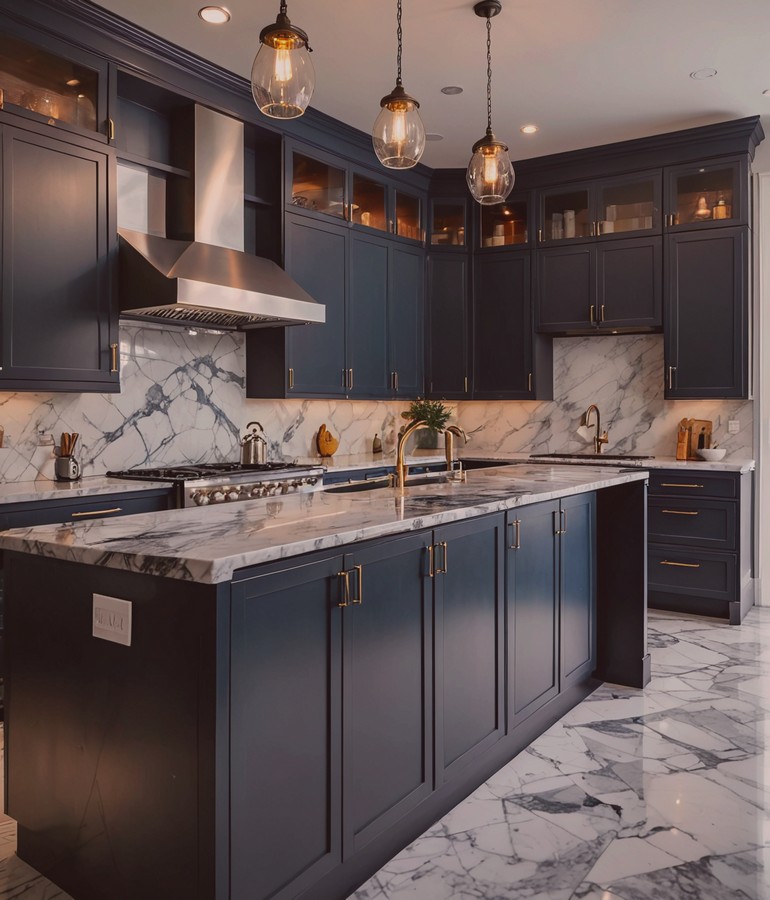COUNTERTOPS SURFACE COMPARISONS
Generally, polished and sealed stone will not stain if any liquid spilled on the top is wiped out within few minutes.
♦ Quartzite
Quartzite is a very hard rock that was originally pure quartz sandstone. Through a process of high heating and pressurization the sandstone is converted into Quartzite.
Advantages:
– Very hardest and the durable
– Highly resistant to stains and scratches
– Heat and burn resistant
– Easy maintenance. Reseal every 2 years
– Highly resistant to UV rays
– Naturally antibacterial
Disadvantages:
– Require sealing
– More expensive than other natural stones
♦ Quartz
Is a man-made product. This “engineered” stone is made from ground quartz mineral (about 92 percent), combined with polyester resins to bind it and pigments to give the colors.
Advantages:
– Extremely hard and durable
– Highly resistant to stains and scratches
– Does not need to be sealed
– Easy to clean with mild soap and water
– Consistent in the color and pattern of each slab
Disadvantages:
– Not heat resistant. Do not put hot pans on Quartz countertops, it will discolor. It will burn with direct fire.
– Sunlight will fate the countertops color.
– Controversial in regards to hazardous toxins during fabrication
♦ Granite
It is mass of molten rock or magma that rose upward and solidified. It is composed mainly of quartz, feldspar, mica and small amount of needlelike crystals and minerals.
Advantages:
– Hard and durable
– Good resistance to stains after it is sealed
– Highly resistant to scratches
– Heat and burn resistant
– Natural unique stone.
– Naturally antibacterial
Disadvantages:
– Seal it once a year
– Granite has pores
– Some granite colors have fissures
– Resistance to stains vary based on the color selected
– Some of the hardest granite, most resistant to stains and not absorbing water if polished: Absolute Black, Black Galaxy, Blue Pear,Volga Blue, Antique Brown.
♦ Nano Glass
Nano Glass is made from natural materials, 75% from quartz sand (silica) and 25% from natural minerals. The silica is molded into the slab form and heated in very high temperature for over 24 hours.
Advantages:
– It is harder than glass. It is extremely dense and strong
– Comparing to granite or Quartz, Nano Glass is much harder to break.
– Nano Glass is heat resistant
– It is nonporous
– Nano Glass is super strong acid and alkali resistant
– With a water absorbency close to zero, it is highly unlikely that this material will absorb any liquids
– Nano Glass is environmentally friendly. It is recyclable
– Maintenance free, it does not have to be sealed.
Disadvantages:
More difficult to fabricate than granite.
♦ Dolomite
Also known as dolostone and dolomite rock, it is a sedimentary rock composed primarily of the mineral dolomite.
Advantages:
– Harder than marble but it is softer than granite
– Good resistance to scratches and stains after sealing
– Heat and burn resistant
– Natural unique stone
– Naturally antibacterial
Disadvantages:
– Sealed at least once a year.
– It has pores.
– Some dolomite colors have small fissures
♦ Marble
Is simply limestone rock that has been compressed and/or heated deep within the earth’s crust. Marble contains primary calcite and dolomite and other minerals; micas, quartz, etc.
Advantages:
– Classic beauty. It is more colorful
– More design options.
– Heat and burn resistant
– Natural unique stone
– Naturally antibacterial
– Less porous than marble or granite
Disadvantages:
– Seal it 2 times a year
– It has fissures and pores.
– Least resistant to stains and scratches
♦ Soapstone
It is talc-schist stone and that talc accounts for the milky or powdery look and feel of the stone. It is mostly composed of the talc, thus it is rich in magnesium.
Advantages:
– Soft feel, when touched feel similar to soap. Many homeowner leave soapstone untreated to develop patina of age
– Scratched can be easily sanded off with a sand paper
– Heat and burn resistant
– Natural unique stone
– Naturally antibacterial
Disadvantages:
– Treat it regularly with mineral oil or soapstone wax.
– Not resistant to scratches
– Limited dark color selection
♦ Laminates (Formica)
Made of synthetic material, a thin layer of plastic that is glued to particleboard or wood.
Advantages:
Low cost
Numerous colors
Easy upkeep
Disadvantages:
Scratches easily
Not heat resistant
Warping occurs from prolonged wetting
Hard to be repaired once chipped.
♦ Concrete
Made of cement, sand, pigment and other additives such as fiber enforcement and acrylic.
Advantages:
– The counters can be pre-cast to fit a mold or cast on site
– Textured look
– Easy to be shaped
– Heat resistant
Disadvantages:
– Must be sealed properly to resist stains and water damage
– Needs occasional waxing to prevent stains
– Cutting on it will leave marks
♦ Tile
Tile countertops come in an arrangement of sizes from 1 inch to 24 inches.
Advantages:
– Easy to install
– Stain resistant
– Heat resistant
– Scratch resistant
– Endless patterns and designs
Disadvantages:
– Tiles have grout lines that must be cleaned regularly so they don’t stain or trap harmful bacteria
– Not a smooth surface
– Chips easily
♦ Acrylic or Polyester Plastic, (Corian, etc.)
Unlike laminates acrylic and polyester plastics are homogenous throughout the material. They come in polished or matte finish. Often more expensive than granite.
Advantages:
Stain resistant
Seamless
Many colors
Easy to clean
Disadvantages:
Scratches easily
Hot pots melt surface
Expensive
Plastic unnatural appearance
♦ Stainless Steel
Sheet metal is mounted to a plywood and usually reinforced with sound deadening coating.
Advantages:
– Heat proof
– Stain resistant
– Easy-to-clean
– Hygienic
Disadvantages:
– Can scratch easily
– Over time it may dent
– Shows fingerprints and water spots
Kitchen Countertops Comparison


